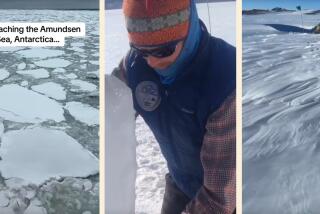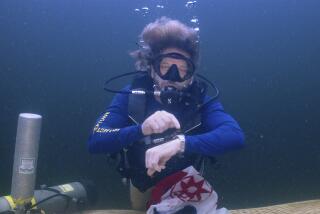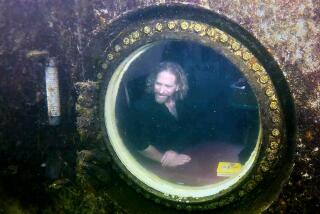Grand Old Man of Oceanography Takes Last Plunge
- Share via
SAN DIEGO — A ready smile crumples Walter Munk’s lined face as he holds out his hand in greeting. At 70, one of the grand old men of oceanography remains ever the gracious host--pointing out the elegant amphitheater sculpted from the hillside below his La Jolla home, asking his guest to join him in an afternoon drink, explaining how he came by his “desk,” a sweeping table salvaged from author Zane Grey’s sunken yacht.
But the fun-loving spirit that has leavened his half-century at Scripps Institution of Oceanography lies buried in nervousness. Here, far from the rolling deck of a research vessel, Walter Munk is at home but at sea.
Amused, his wife Judith urges Munk to relax for the photographer, who wants to capture the man widely regarded as one of the two or three most influential oceanographers in the world.
“You make acoustic signatures and I can’t relax,” Munk grouses in his best scientist’s jargon. He asks the young man to leave.
Such a display of anything less than supreme confidence is indeed a rarity, say Munk’s friends and colleagues. But, then, there’s plenty to be confident about.
Munk helped develop ways of forecasting waves that put Allied troops onto the beaches of North Africa and Normandy in World War II.
He took what one collaborator describes as “astronomers’ noise” about planetary changes and developed explanations of how the Earth’s axis shifts and its rotation changes during and after Ice Ages.
He showed how storms near Antarctica bring La Jolla’s summer surfers the periodic trains of waves they love.
He explained the natural phenomena behind Venice floods in 1966, making it possible for Italian officials to correct the problem.
And, even as he formally retired from his position of professor of oceanography at UC San Diego on Thursday, he was dreaming of how a new way of taking ocean temperatures by listening to underwater sounds might give the best measure yet of how the greenhouse effect is warming our planet.
His colleagues say this latest idea seems more of a pipe dream, Munk notes with a laugh. If it proves correct, though, it won’t be the first time Munk has had the last laugh in a scientific debate.
“One of Walter’s great talents has been his ability to identify important topics, regarded by others as intractable, where progress can be made. Each time he demonstrates this, the criticism of the rest of us slowly turns to admiration,” Christopher Garrett, now of Canada’s Dalhousie University and a former post-graduate researcher at Scripps, wrote in 1982.
Munk looks back with amusement and no false modesty on an oceanographic career that started on a whim in the late 1930s. Having been sent from his native Austria to New York to learn the family banking business, he hated the city so much that he resolved to get as far as possible from it. Thus began a trip to Caltech, where he graduated in physics in 1939.
But the summer of 1939 held a summer job at Scripps--sought because a girlfriend vacationed in La Jolla--and Munk became a doctoral student at Scripps in 1940. “For some time I constituted the Scripps student body,” Munk says.
From a collection of about 15 people in those early days, Scripps has grown into one of the preeminent ocean research centers in the world, with more than 300 faculty and researchers, 170 students and a $50-million research budget.
“We’re both pioneers in oceanography,” notes Roger Revelle, director emeritus of Scripps. “And in those days there wasn’t much known about it, so you could work in a lot of different fields and not feel like an amateur. You were an amateur, but you didn’t feel like it.”
World War II brought Munk, Revelle and others at Scripps into working for the Navy at San Diego’s Pt. Loma, figuring out the solutions to the problems of amphibious warfare. As the U.S. commitment to oceanography expanded after the war, Munk became a prime beneficiary.
His work on waves, tides and other ocean phenomena since then has been largely financed by the U.S. Office of Naval Research. (Indeed, the Navy endowed the academic chair he will continue to occupy at Scripps despite his official retirement from the university payroll.)
Fondest Memories
Some of his fondest memories are of the long expeditions to sea that were characteristic of oceanography’s earliest days. Today, scientists fly to a port, get aboard ship for a couple of weeks and then return to port to fly home. This is more efficient but less colorful, Munk laments.
“I’m glad I saw the end of the real expedition era when I was a student here,” he said. “You were just gone forever. When you came back home, you sort of felt you had spent your life at sea, and you were beginning to see something totally unfamiliar.”
Munk returned to eventually spend 23 years as head of the Scripps branch of UC Berkeley’s Institute of Geophysics and Planetary Physics, a title he gave up in 1982 in anticipation of his retirement this year.
The ‘60s were expansive years for oceanography and Scripps. “That was a fantastic time,” said Douglas Caldwell, a former Scripps researcher and now dean of oceanography at Oregon State University. “There were Nobel Prize winners coming across the mountains in the 1960s like Okies in the ‘30s.
‘Wonderful Place’
“It was really a wonderful place to work because of all these people, and also scary because they’re kind of intimidating for a young kid,” Caldwell said.
How did students react to being around pioneer Munk? “When you worked around Walter, everyone was an underling,” Caldwell said.
Although Munk and his wife and two daughters traveled all over the world for short periods for his work, they always returned to their distinctive house above the ocean, in a subdivision started by Scripps researchers. He rejected the inevitable job offers elsewhere--including two from the renowned Woods Hole Oceanographic Institution in Massachusetts. He explains it simply: “I have absolutely the world’s best job.”
Generalist’s View
As he moves into a retirement in which he will continue to do research at Scripps, Munk sees a future for oceanography in which students will have to adopt the kind of generalist’s view of the oceans that was common in the early days.
“It will become more interdisciplinary, which is what it was when I first came in,” he said. “We all knew what was happening in biology and chemistry and geology because we were such a small group of people. And then it became quite specialized.”
Long an influence on defense and ocean science policy nationally, Munk is now mulling a request to use his expertise on a committee that advises the National Aeronautics and Space Administration on its future.
And he plans to spend his “last chance” at doing something significant for science by trying to figure out how to measure the possible warming of the oceans from the greenhouse effect.
Heard Island
His face alight with imagination, Munk talks of tiny, volcanic Heard Island in the southern Indian Ocean.
“It’s so located so that it has a ‘view’ around the world in two directions,” he said. “If you could see along the surface of the Earth you could see Bermuda from Heard.” Looking another direction, one would see the San Francisco Bay Area.
The idea is to position a powerful sound source off Heard Island in the southern Indian Ocean and then listen to it underwater in both directions. Using ocean acoustic tomography, which Munk and Carl Wunsch of MIT have pioneered, scientists would measure water temperatures from Bermuda southeastward and around Africa and Australia to the U.S. West Coast. This can be done with sound waves because the higher the water’s temperature, the faster the sound travels.
If the project proves possible--”I might be able to say something meaningful about it in a year”--it would resolve the uncertainties of current debates over the greenhouse effect.
Even Munk’s own assessment of the scientific process mitigates against success: “You have an idea. It’s almost surely wrong. The equipment is almost surely not working the way you think it ought to.”
But it’s the kind of challenge from which Walter Munk has never shied.






